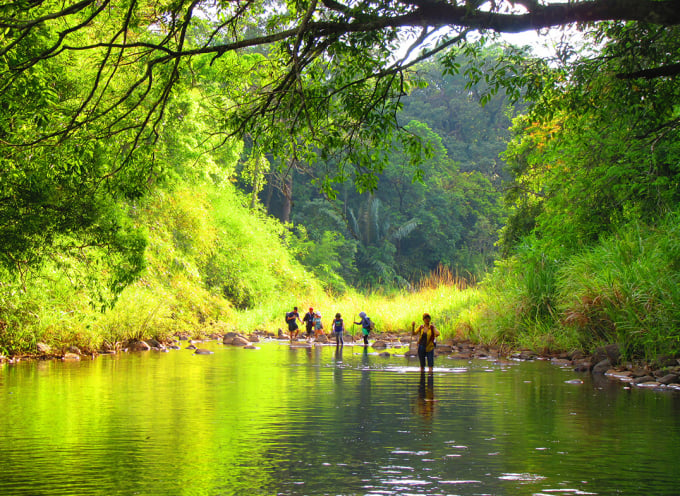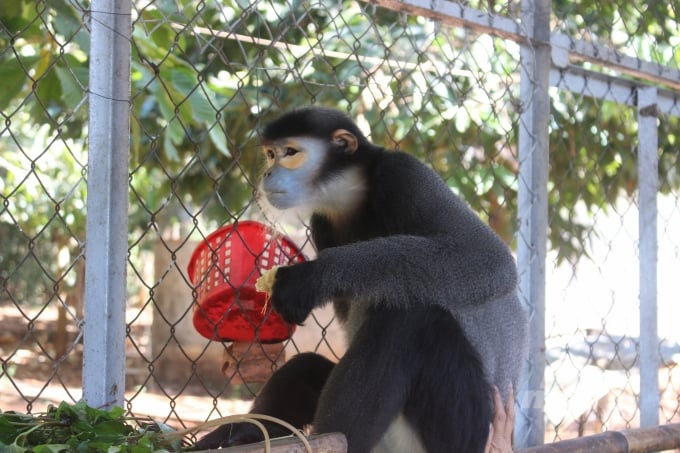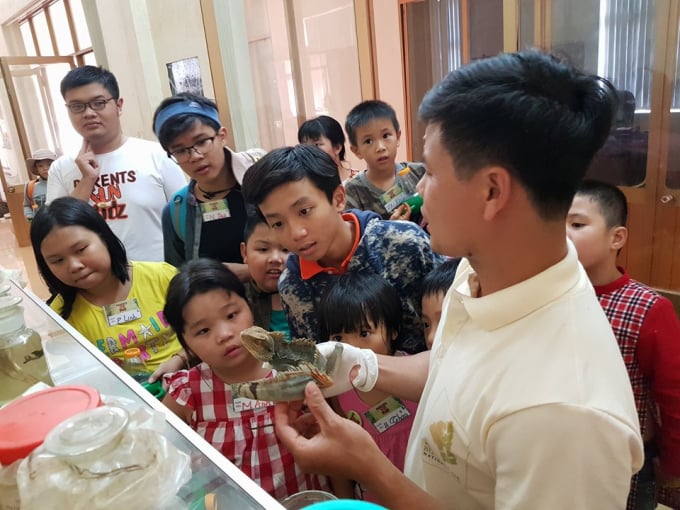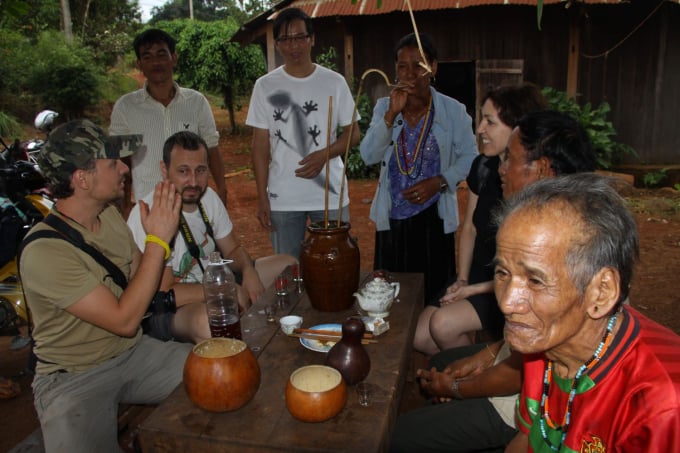May 29, 2025 | 10:15 GMT +7
May 29, 2025 | 10:15 GMT +7
Hotline: 0913.378.918
May 29, 2025 | 10:15 GMT +7
Hotline: 0913.378.918
Located in Bu Gia Map district, Binh Phuoc province, Bu Gia Map National Park is more than just a place to conserve the biosphere resources of the Southeast region. On the eve of a new spring, this land gifts us with many interesting discoveries.

Bu Gia Map National Park - the “green lung of the Southeast”. Photo: Tran Trung.
With a total area of over 25,778 ha, Bu Gia Map National Park is considered the “green lung” of the Southeast region. This place is a watershed protection forest for Thac Mo, Can Don and Srok Phu Mieng hydropower projects, a “safe-haven” for many ecosystem-standard samples and rare genetic resources of flora and fauna.
Walking among the primeval forests of Bu Gia Map National Park, it’s as if we could feel the cool air radiating from branches and leaves. Sometimes in the forest, a babbler’s silvery singing reverberates through the serene mountains. It was such a compelling feeling that captivates the heart of many tourists visiting Bu Gia Map National Park these days.

Phayre's langur - one of the animals listed in the Red Book of Vietnam, currently under the protection of Bu Gia Map National Park. Photo: Tran Trung.
Mr. Kieu Dinh Thap, Head of the Department of Environmental Education and Forest Environmental Services in Bu Gia Map National Park, said that in recent years the park has always concentrated on developing tourism and initially brought positive results.

Bu Gia Map National Park is an ideal destination for students to gain experience and knowledge, thus raising their awareness of forest protection. Photo: Tran Trung.
“Bu Gia Map National Park is an ideal destination for juveniles from schools in the province and Ho Chi Minh City to observe the flora and fauna ecosystems and improve their survival skills. Students are all excited as they have the chance to interact and look at the animals up-close instead of just looking through books and pictures.
"There are in fact many other attractions that visitors cannot set foot in because of the rugged and deep terrain in the forest. The accompanying service activities and rest stops for tourists are not yet well-equipped. In order for tourism to develop, it is necessary to further invest in transport infrastructure and accompanying tourism service activities for the park’s development to be deemed commensurate with the potentials and strengths it possesses,” said Mr. Kieu Dinh Thap.

Bu Gia Map National Park is becoming a gathering place especially for young people, suitable for a wide variety of experiential activities. Photo: Tran Trung.
According to our findings, the majority of people in the buffer zone of the national park have extremely difficult living conditions. The population is concentrated in remote areas of Binh Phuoc and Dak Nong. More than 80% of them are ethnic minorities with low level of education and low awareness of law compliance.
Through contracts on forest keeping and development of ecotourism, people’s lives have started to turn on a new leaf.
More than voluntarily participating in forest protection, they become tour guides, the "eyes and ears" of the Park Management Board who can immediately file a report whenever they detect forest violations.

People in the buffer zone of the park preserve many original cultural traits. They are actively focusing on their inherent resources to develop various types of ecotourism inside and around the park’s forest area. Photo: Tran Trung.
“Indigenous ethnic communities including the S'Tieng and M'Nong people are still preserving many original cultural traits such as gong festivals, weaving brocade, making traditional tools and rustic dishes imbued with ethnic identities such as straw liquor, Thut soup, Djaq pai (another indigenous soup), and bamboo rice. They are actively focusing on their inherent resources to develop various types of ecotourism inside and around the park’s forest area," said Mr. Vuong Duc Hoa, Director of Bu Gia Map National Park Management Board.
Ecotourism harmoniously combines all three economic - social - ecological values, having proven its efficiency as a sustainable form of tourism. Instead of the fear of degradation, both natural and social environments now find themselves more consolidated for long-term development.
Binh Phuoc is currently developing a master plan for tourism development in the 2021 - 2025 period. Key tourism projects will be the main focus for investment to make the national park a signature tourism product, an attractive destination with a complete service system.
the province will concentrate resources specifically on several projects such as: Special National Relic Area of the Command of the Liberation Army of South Vietnam with activities to learn about history; Cultural - Healing Complex of Ba Ra mountain with spiritual-healing and resting activities; and Bu Gia Map National Park Ecotourism Area with exploration and experiential activities.
Translated by Samuel Pham
/2025/05/25/4127-3-073637_820.jpg)
(VAN) Thanks to the promotion from an FAO-implemented project, vegetable production in greenhouses in Moc Chau has seen strong development, from 1.5 hectares in 2021 to nearly 50 hectares in 2024.

(VAN) FAO has recently supported USD 140,000 to implement the project 'Risk mitigation human-animal interface risks through disease control initiatives in pig farming.'

(VAN) The People's Committee of Tra Vinh province has approved an adjustment to the investment policy for the Green Hydrogen Plant project, increasing its area to approximately 52.76 hectares.
![Reducing emissions from rice fields: [2] Farmers’ commitment to the soil](https://t.ex-cdn.com/nongnghiepmoitruong.vn/608w/files/news/2025/05/05/dsc08881jpg-nongnghiep-140632.jpg)
(VAN) Clean rice cultivation model in Thuong Tan commune, Bac Tan Uyen district, is assisting local residents in achieving sustainable agriculture by substantially reducing costs, increasing productivity, and protecting the environment.

(VAN) At the conference to disseminate Resolution No. 68, AgriS introduced its digital agricultural ecosystem and reaffirmed its commitment to accompanying the Government in promoting private sector development and sustainable agriculture.

(VAN) 'Blue Ocean - Blue Foods' initiative is designed to restore marine ecosystems and establish sustainable livelihoods for local communities by cultivating a minimum of 1,000 hectares of cottonii seaweed in the first three years.
/2025/05/21/4642-3-112707_603.jpg)
(VAN) The V-SCOPE project has made direct contributions to three out of six pillars of the Comprehensive Strategic Partnership between Vietnam and Australia.